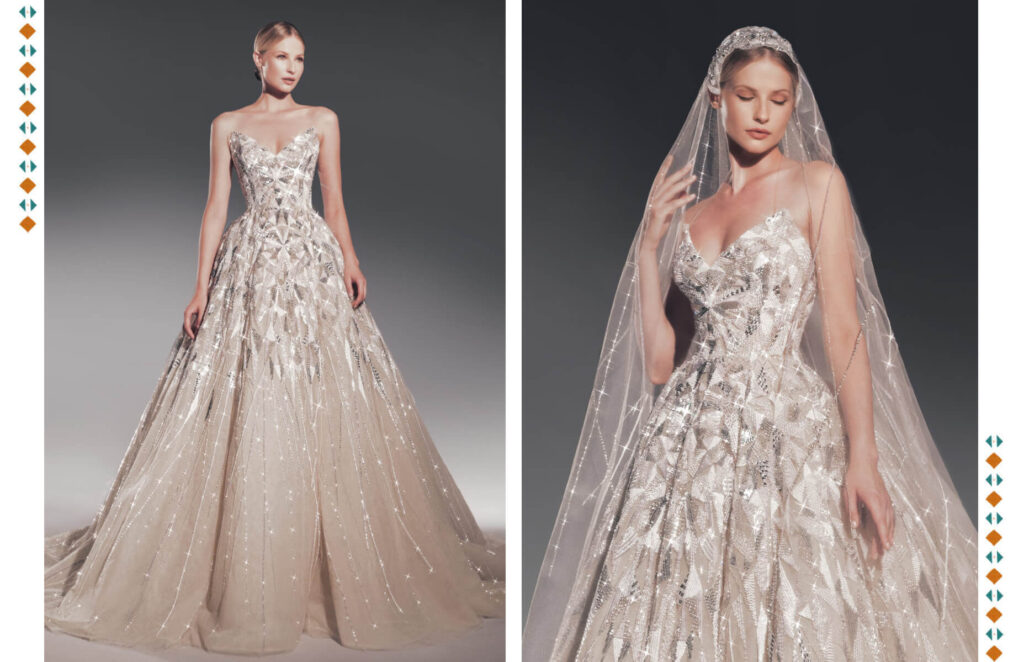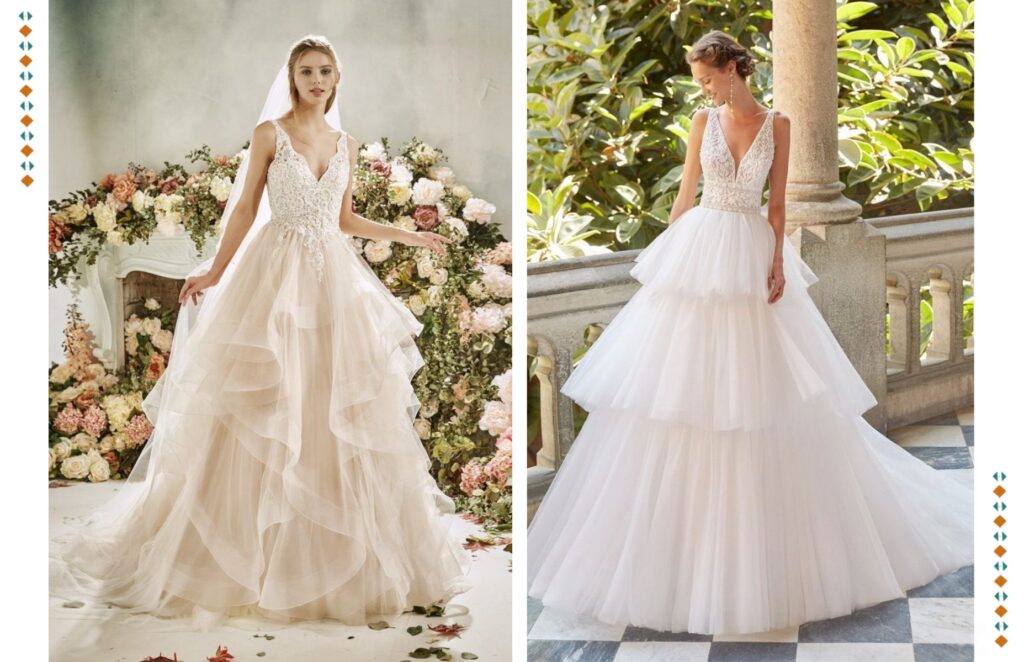There’s no outfit or piece of fashion that’s quite as iconic as a wedding dress. These gowns—which can range from ultra-simple to extraordinarily elaborate—serve as the focal point of millions of weddings each year. “For many, wearing a wedding dress is a once-in-a-lifetime experience,” says Michael Cho, the head designer at Amsale. “A wedding dress is designed to frame the beauty, and exude the radiance, of someone who is the very center of attention at one of life’s most memorable events.”
The History of Wedding Dresses
Though it seems like wedding dresses have been around forever. The white embellished gowns we know and love really only date back to the 1840s explains Cho. This was all thanks to Queen Victoria, who wore a cream-colored silk and lace dress for her wedding to Prince Albert. Prior to the fashion-forward Queen’s nuptials, wearing white was typically reserved for women being presented in court. Royal brides wore a variety of different colors while non-royals simply donned their nicest outfits to tie the knot. After Queen Victoria’s nuptials, however, other influential leaders followed her elaborate style when choosing their big-day attire. Cho adds that white dresses for the everyday bride became popularized in the United States during the early 1900s, gaining even more traction after WWII.
And though we so often associate a white gown with a wedding. Madeline Gardner, the head designer at Morilee, explains that, worldwide, this is actually not the norm. “While white and shades of ivory are the go-to option for most western cultures, eastern cultures actually opt for bold colors. Most often red, symbolizing good fortune,” she explains. “Wedding gowns have evolved so much over the years. But their symbolism and importance to the brides wearing them always remain true.”
Cho says that the modern wedding dress we’re so familiar with today dates back to the 1980s. In fact, when designer Amsale Aberra couldn’t find a more contemporary silhouette for her 1985 nuptials. She set out to create a chicer option herself. “[Amsale] eschewed the overly ornate—which was on-trend in that era—and crafted her own pared-down design that was elegant in its simplicity and quiet in its impact,” he explains. “Since then, Amsale has been widely credited as the inventor of the modern wedding dress.”
How Are Wedding Dresses Made?
Wedding dresses are an integral part of many marriage celebrations and there are more options than ever to choose from. Ball gowns, breezy bohemian styles, chic sheaths, and vintage-inspired ensembles might seem vastly different, but they all start from the same place: inspiration. “For each new collection, I create multiple mood boards, gathering photos and ideas that will inform my designs,” explains Cho. Beyond that, it’s a whirlwind of fabric and embellishment selection, design sketches, mannequin draping, and pattern creation.

The Conceptualization
Before a bride can decide whether or not she’s found “the one,” the design team has to first dream up the dress itself. For Cho, this means zeroing in on the emotion the gown will evoke, such as romantic, sensual, nostalgic, or playful. “This is a team process and is very important as we discuss concept, silhouette, brand, and market needs,” he notes. To ensure each garment is true to the desired aesthetic, Cho and his team creates the aforementioned mood boards to help guide their design work. “I look for inspiration all around me,” he says. “It can come from travel, art, icons—I love to create and tell a story behind the mood board.”
The Fabric Sourcing
After determining what a gown will look like and what feelings it will invoke, designers will then gather the fabric, embellishments, and beading needed prior to making their first stitch. Sourcing fabric is timely and can take anywhere from three to four months, Cho explains. “For each collection, we select fabrics and embellishments based on the inspiration and mood boards. Often working directly with the mill or beaders to create our own unique fabrics.” Gardner carefully selects her fabrics, too. “I source fabrics and laces globally to bring the most unique feeling to each gown,” she explains. “Doing so breathes an element of diversification across my designs, something that really speaks to the fact that Morilee is a global brand catering to different tastes, trends, and brides from all over the world.”
Once everything has been selected, the waiting process begins. Fabrics typically take about 60 to 90 days to arrive at a designer’s workshop, Cho shares, while beading can take over a month depending on how complex it is.
What’s more, some plain fabrics and solid fabrics are stored in-house at designers’ ateliers. Most come from fabric mills in exotic places around the world. “Many designers have favorites they work with again and again”. Cho shares, depending on the type of fabric he’s looking for. He’ll source from various mills based on their specialties. A few of his favorites include a family-run lace mill in Calais, France, and a small family-owned silk mill in the Lake Como area of Italy. Also the specialty beading and fabric manipulation houses in India.
The Construction
The construction of the gown is one of the most time-consuming components of the whole process. It all starts with the inside foundation, usually consisting of the blouse and petticoat. “These are extremely time-consuming to make; it can take hundreds of yards of tulle for the inside skirt and petticoat,” Cho reveals. And since Amsale—like other luxury bridal houses—hand cut and hand sew their gowns to guarantee quality and precision. The meticulous internal creation process can take months. Once the silhouette of the gown is complete, next comes the outer fabrication and details such as hand-placed lace or embellishments.
If this is a new design that’s being considered for a future collection, it’ll then be fit and refit multiple times before getting a final review from the head designer. Upon receiving approval, the wedding dress is then presented to buyers and editors during Bridal Fashion Week. “That’s how brides get their first glimpses of the design,” Cho explains.

The Timeline
If you’ve ever wondered why brides have to start shopping for dresses so far ahead of their wedding dates, it all comes down to production time. “It’s important to remember each dress is created specifically for each bride,” explains Cho. In fact, most bridal gowns are made-to-order (unless you buy a wedding dress that’s pre-owned or off-the-rack) and expensive to make. So designers typically don’t have many pre-made gowns sitting around. “Fabric must be sourced, any embellishments must then be created that match the fabric (often involving meticulous handwork). And then each garment must be cut to size and sewn one by one, by skilled artisans,” Cho shares. Since patterns are based on each bride’s measurements. Designers don’t even begin construction or sourcing until a to-be-wed official place their dress order.
It can take anywhere from several weeks to several months to create one wedding dress, Gardner explains. “Factors like the level of intricacy in the pattern itself, complexity of layering, the amount of hand beading and embroidery on a gown, and so forth [all impact timing],” she explains. “These different facets can add a significant amount of time to the process. No matter what the design, it’s always made with love!”
Once the gown is made, Cho explains that it goes through quality control prior to shipping. This is when designers ensure embellishments are secure and the overall look is perfect. However, the preparations aren’t over once the bride receives the dress. “It takes multiple fittings and alterations before the final wedding gown is ready to be worn,” Cho notes. This is why he suggests ordering your look at least eight to 10 months before your big day and leaving two months for alterations.


